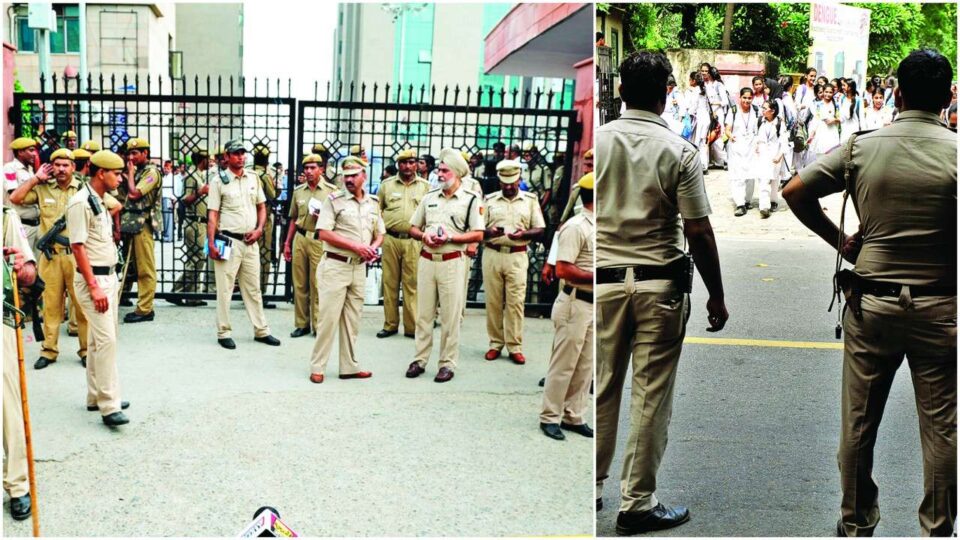The rate of registration of crimes in the national Capital has gone up fourfold in the last seven years. Cases of theft that have jumped by a whopping 1,530 per cent — from 6,313 in 2011 to 1,02,954 in 2017. Burglaries saw a tenfold increase till 2016, but dipped this year, latest police data shows. Vehicle thefts have also more than doubled during this period. As for heinous crimes, they rose steadily from 2011 to 2015, but came down in 2016. But non-heinous crimes have continued to spike since 2000.
In 2011, the total number of cases registered was 53,353. It was 54,287 in 2012 that grew to 80,184 in 2013. The number further grew to 1,55,654 in 2014, and 2015 recorded 1,91,377 cases. In 2016 a total of 2,09,519 crimes were registered. This year, till November, the figure was 2,13,151. Officials say that the rising numbers are because of better reporting of cases and do not reflect poor law and order. A number of initiatives have been taken by the Delhi police to encourage registration, they say.
“People in Delhi have good access to the police. If one wants to report a crime, it won’t remain unreported. We have zero-tolerance towards non-registration of crimes. Moreover, facilities like online registration of FIRs through mobile phone apps have made the task hassle free and less time consuming. We must appreciate more registration of crimes so that no crime goes unreported. Citizens must become the eyes and ears of police to help eradicate every form of crime in society,” a senior police officer said.
Take the case of Param Srivastava, an IT professional. He had his mobile phone stolen from a market near his residence in East Delhi. Having a hectic work schedule from 10 am to about midnight, what he could do best was to file an e-FIR and let the matter rest with the police for investigation.
“I was not aware of this system. To get a new SIM card of the same number I needed to file an FIR and filing it online saved me a lot of time and energy. Even if the phone could not be recovered, my work did not get affected. However, the police also needs to take these FIRs as seriously as the ones registered by complainants physically, in police stations,” he said.
The police says that such measures from the force encourage people and victims of crimes to come forward and raise their voice. “Registration of a crime is the first step towards raising your voice. It also allows the police to probe and ensure justice. Such measures have also encouraged women and girls to come forward and report,” he added.
“One can simply go to the Delhi police’s website and lodge a complaint. That complaint is then turned into an e-FIR and a receipt is generated for the user, for future reference. Moreover, one can even check the status of her complaint on the website. Apart from these, policing apps are available on cell phones and women safety apps have also been launched to make police accessible anywhere and everywhere,” he said.
About three months ago, Isha, who works as a content producer at a private firm, got her laptop stolen from her house. “My residence where I live as a paying guest with two other women, is quite a public place. It is not easy to find a suspect. The ability to solve a crime is a different debate altogether, but I found reporting the theft a very easy and time-saving process. My parents might have otherwise not liked the idea of my visiting a police station at odd hours,” she said. However, increasing street crimes cannot be ignored and vigil needs to be stepped up at a number of stretches in Delhi, she said.
Rising Crimes
But heinous crimes are the biggest worry. Delhi accounts for the maximum number of rape cases among 19 major cities at 40 per cent, besides the highest crime rate in 2016, according to the National Crime Records Bureau (NCRB) data. The national Capital has got the dubious distinction of topping the list in cases of murder, kidnapping and abduction, juveniles bring in conflict and economic offences. Delhi reported 33 per cent (13,803 cases out of total 41,761 cases in 19 cities) of total crimes against women, followed by Mumbai at 12.3 per cent (5,128 cases) last year among the 19 cities with population above two million.
The national Capital reported nearly 40 per cent of rape cases and nearly 29 per cent of each of cruelty by husband and his relatives and dowry deaths, the NCRB data said. Delhi accounted for 38.8 per cent of total IPC crime reported in 19 cities, followed by Bengaluru (8.9 per cent) and Mumbai at 7. 7 per cent. The national Capital recorded the highest crime rate—182.1 compared to the national average of 77.2. Delhi reported the highest number of kidnapping and abduction—5,453 cases (48.3 per cent) followed by Mumbai with 1,876 cases (16.6 per cent) and Bengaluru with 879 cases (7.8 per cent) during 2016.
The city reported the highest number of murders— 479 out of 2,194 cases (21.8 per cent)—followed by Bengaluru at 10.4 per cent (229 cases) and Patna at 8.9 per cent (195 cases). The highest number of cases—at 35.6 per cent (2,368 cases out of 6,645)—of juveniles in conflict with law were reported in Delhi among the 19 cities during 2016.
Delhi has reported the maximum number of cases under economic offences—5,942 cases (19.3 per cent)—followed by Jaipur (4,742 cases) and Mumbai (4,191 cases), accounting for 15.4 per cent and 13.6 per cent respectively during 2016. In cybercrimes, Mumbai reported the highest number of cases—980 (23.5 per cent) out of 4,172 cases in 19 major cities in 2016.
The crime scenario in Delhi cannot be compared with other metros because the city has different policing requirements, Delhi Police Commissioner Amulya Patnaik said recently. “In terms of policing requirements, since it is the national Capital, Delhi has got VIP security, law and order arrangements which are typical to Delhi. The city is a separate class in itself and it can only be compared to Delhi of the previous year,” Patnaik told PTI.
Poor Strike Rate
But the data also shows that cops are struggling to crack cases. The Delhi police’s average crime solving percentage across all its administrative districts till November 19 this year was low as 33.37 per cent. This is when the NCRB has ranked the city as the worst in increasing crime cases. Confidential police documents accessed and reported by DNA recently showed that the force has been struggling to clear case backlogs.
The New Delhi district is the worst despite having the biggest police deployment. It managed to solve only 23 per cent of the 3,120 cases. Then comes Rohini that could solve 26 per cent of the total 18,046 cases. The North district achieved a rate of only 29 per cent. It registered 9,513 cases. It is followed by the Southeast that could solve 30 per cent of the 20,549 cases.
The East district scored 31 per cent. It registered 15,659 cases. The outer district managed to solve 33 per cent of the 14,961 cases. The Northwest also clocked 33 per cent. It recorded 19,400 cases. The police in West, Southwest and Northeast districts have solved 36 per cent of the 16,105, 14,474 and 15,613 cases, respectively. The Central district recorded 9,564 cases and solved a 37 per cent of them. The Shahdara district performed better and scored 41 per cent. It recorded 12,798 cases. The South district has fared the best. It solved 44 per cent of the 19,786 cases.
The IGI airport police, which does not usually witness heinous crimes at it falls in a sensitive zone and has round-the-clock security by the CISF, solved 56 per cent of the 577 cases that included only one murder and a rape as heinous crimes. Railways and Delhi Metro, however, were the worst in non-major police pockets. Both solved 21 per cent and 22 per cent cases, respectively. The Railways recorded 3,683 cases, while the Metro saw 11,872.
Police Claims
Officers say a number of measures have been taken for crime control. These include more participation of the public in assisting cops in monitoring large areas. “Certain steps which have been of major help are integrated patrolling with traffic police and the police control room, regular bike patrolling to ensure visibility and group patrolling in areas more prone to criminal activities,” a senior official said. Further, initiatives which demand public participation are like Sashakti self-defence training camps, anti-snatching teams and use of local area security guards to assist beat constables and act as force multipliers and Prahari schemes, he said, also mentioning area-wise crime mapping, identification of vulnerable and escape routes used by local criminals, picket checking at crime prone stretches.




